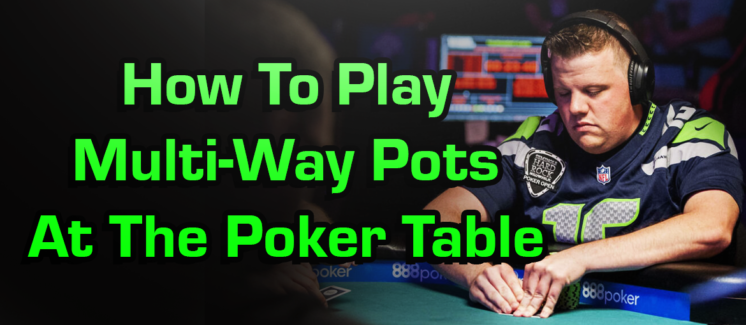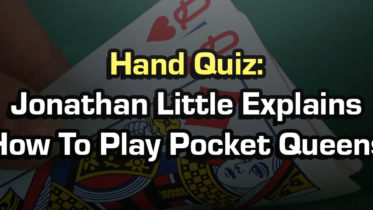Knowing how to navigate multi-way pots is an extremely important tool of any tournament player. Especially at lower stakes, multi-way pots are quite normal as players have expanded calling ranges. These spots however often go unstudied due to the complexity of the math behind these situations.
Current GTO poker solvers focus on heads-up situations and can solve them in a few minutes. It can take hours, if not days to solve a simple multi-way spot in a GTO calculator such as Monker Solver. Today I will discuss a few baseline principals of multi-way pots that you can implement in your game.
Understanding The Equity Of Multi-Way Pots
First, we are going to discuss the concept of pot share. When two players enter a pot, the average equity between the two is 50%. It may be 45/55 or even 40/60 split however it won’t deviate too far from that 50-50 split in equity. When your range has 45% equity against the villian’s range, you “own” 45% share of the pot currently, meaning over the long run you can expect to return 45% of the money in the pot. In multi-way pots, pot shares get smaller due to multiple ranges in the hand.
When 3 players enter the pot, they each have an average of 33% equity. A large range advantage on certain board textures may result in the stronger range having a 40% pot share, however it is very difficult to have any more than a 50% pot share 3 ways. This gets even worse when 4 or 5 players enter the pot where average pot share is between 20-25% of the pot. As you can see, it is very difficult to win multi-way pots, even with strong ranges due to pot share of the other players in the pot.
Implementing Knowledge Of Betting Frequencies
This leads to the next topic of this article which is betting frequencies. I have previously written about why we get to continuation bet and the factors that allow it. Those include equity advantage (pot share) and nut advantage.
In a 3-way pot when you only have 35-40% pot share, it is hard to justify betting often. We are bloating a pot that we will more often than not lose. With multiple ranges in the pot however, protection becomes more important.
Let’s take a hand like K-Q on a K-9-5 rainbow flop. Heads-up if you are against a hand like 6-5, your hand doesn’t require much protection, the villain only has 5 outs. However, take a 3-way example where one player has 6-5 and another has A-9, combined now they have 10 outs between them and your K-Q only has 60% equity instead of 80% in the previous heads-up situation. Because of this, betting for protection becomes very important in multi-way pots. In summary, we bet less frequently in multi-way pots and when we do, it is often to deny equity to our opponents for protection.

Bet Sizes In Multi-Way Pots
Next, we will talk about bet sizing. Fundamentally, what allows you to bet large is having both a nut advantage and a large equity advantage. Both properties must be present to justify a large bet.
When discussing a large bet, I am referring to a ¾ size bet all the way to an over bet. The key thing in multi-way pots is that neither of these properties is present with multiple hand ranges in the pot. The adjustment to be made is to bet smaller to deny equity and help increase our pot share for later streets.
In multi-way pots, a standard bet should likely be around 25-33% of the pot. While a large bet in a heads-up pot may be full pot, in a multi-way scenario, there should almost never be a bet larger than 50% of the pot. Your range simply never has a large enough equity advantage to justify a larger bet.
The Importance Of Position
Finally, I will talk about relative position post-flop and getting into the habit of squeezing players. Let’s look at an example where you raise first to act and a player in middle position flat calls and the button calls and you go three ways to the flop.
In general, the middle position player that flat called likely has the strongest range of the three players as they chose to call versus a UTG raiser with multiple players left to act. The button still has a strong range, but can call wider than the middle position player due to having guaranteed position throughout the hand. The flop comes 9-5-2 rainbow and we bet 1/3 pot.
We are now “squeezing” the strong range in the hand the middle position player. The MP players must call TIGHTER because of the range of the button behind. This puts the middle position player in a tough spot and forces more folds and allows us to get heads-up more against the weaker button range. In general, the first cold caller in a hand always has the strongest range but has the worst relative position because in a multi-way pot they must worry about players left to act behind.
Concluding Multi-Way Pots
In conclusion, we need to play much more carefully in multi-way pots than in heads-up pots. Bets should be less frequent and for smaller sizes. Protection becomes more important multi-way than heads-up due to the presence of more hand ranges. Finally, you should learn to manage your expectations in multi-way situations. You have a smaller pot share and will win the pot less often when playing multi-way.
Best of luck at the table,
Matt



